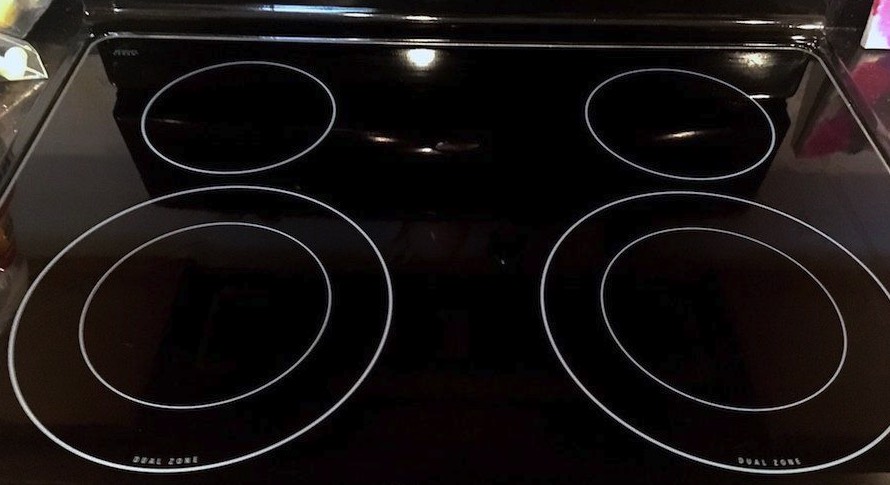Glass cooktops add a sleek and modern look to your treasured kitchen. They also reduce the stress of cleaning or replacing burner grates. However, when using a glass cooktop, you may realize that the smallest spill or stain is noticeable.
Therefore, you must clean them as soon as possible to prevent a sticky and unpleasant mess. Stubborn stains make your glass cooktop dirty and poorly maintained, and as a frequent oven user, you may want to remove them fast.
Read more to learn how to get tough stains off a cooktop and make it sparkling clean.
Guidelines for cleaning a glass cooktop
It would be best to clean the glass cooktop daily because of the daily cooking and spills. Remember to let it cool down before you begin the cleaning routine.
For the best results, you will need a spray bottle of water or distilled white vinegar and a cloth or sponge to wipe the glass cooktop. This procedure isn’t different whether you are working with a white glass cooktop or any other for that matter.
Here are the steps to follow when cleaning a glass stovetop:
- Spray the cooktop (or specific areas that have stains) with water or white vinegar.
- Wipe the liquid with a cloth or sponge.
- Wipe off the streaks with a dry cloth.
READ: A review of the Inkbird wireless meat thermometer
How to clean a very dirty glass cooktop
To clean a cooktop that is very dirty, you need the following items:
- Baking soda
- Spray a bottle of distilled white vinegar
- Dry towel
- Basin filled with hot water
- Cloth or sponge
Follow these steps to clean a glass cooktop that is very dirty:
- First, dry-wipe the dust before you start cleaning the cooktop.
- Next, spray the cooktop’s surface with white vinegar.
- Sprinkle baking soda over the surface.
- Dip the towel in hot water, wring out the excess water and place it over the surface.
- Let the towel rest for 10 to 15 minutes.
- Remove the towel and wipe the surface with a cloth or sponge.
- If the stains are stubborn, spray some vinegar and wipe off the liquid with a clean cloth.
- Repeat the above steps until all the residues are banished and the glass cookpot is clean.
One maintenance tip to follow especially if your cooktop gets dirty frequently is to maintain a biweekly or monthly routine. This way, you’ll keep your white or black glass cooktop looking brand new all the time
READ: How to descale a Cuisinart SS-10 coffee maker
Using a razor blade
Though this method is not highly recommended, a razor blade efficiently eliminates the stubborn burnt-on rings around the burner. Aside from a razor blade, you also need a spray bottle of distilled white vinegar and a cloth to wipe the cooktop.
Check the manufacturer’s instructions before you use a razor blade to clean a glass stovetop. Do not use it if the instructions are against it.
Remember to let the oven cool before starting the cleaning process. Follow these steps to clean a burnt glass stovetop:
- Spray the dirty areas on the surface with vinegar to soften the burn-on residue.
- Gently scrape the residue with a razor blade until it comes free. Note that you should not scrape with the edges of the razor to avoid scratching the cooktop surface. Instead, hold the blade at a slight angle and remove the stubborn stains on the glass cooktop.
- Wipe away the stain with a clean cloth or sponge.
- Repeat the above steps until your cooktop is residue-free and clean.
What is the best cleaner for a glass cooktop?
The best cleaners for glass top stoves are baking soda and vinegar which are easily available at home. They help soften and remove the stubborn stains on the glass surfaces easily.
Steer off from chemical cleaners since they may cause the chemical residue to burn when you cook. The burning chemical residue may emit toxic gas that is dangerous to your health. To avoid this, spritz vinegar on the surface and sprinkle baking soda on it to get rid of stubborn stains easily, efficiently, and safely.
Soaps or soap-based cleaners should not be used on black stovetops because they make them look like they are smeared.
You should also use a microfiber cloth or sponge instead of harsh cleaning tools such as hard-bristled brushes, steel wool, or the rough side of the sponge. They may leave little scratches on the cooktop’s surface and ruin its sleek appearance when used.

